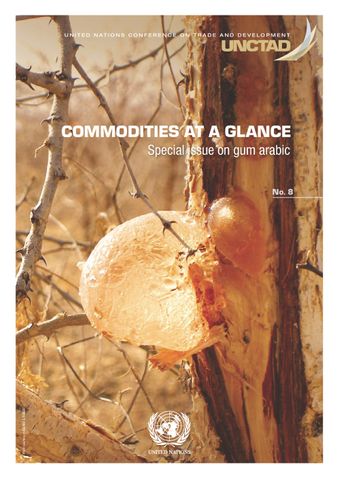Introduction

- Author: United Nations Conference on Trade and Development
- Main Title: Commodities at a Glance: Special Issue on Gum Arabic , pp 1-6
- Publication Date: May 2019
- DOI: https://doi.org/10.18356/0727ad55-en
- Language: English
- Previous Chapter
- Table of Contents
- Next Chapter
Gum arabic is a dried exudate obtained from the stems and branches of certain species from the Acacia genus.1 Given its many desirable properties, safety record and natural origin, it is the most commercially valuable exudate gum, with wide applications in industries as diverse as food and beverages, pharmaceuticals, cosmetics, printing, ceramics, photosensitive chemicals, pyrotechnics, textiles, paper, ink, paints and adhesives. Produced primarily in arid wooded savannas in sub-Saharan Africa, but also in smaller quantities in South Asia and the Arabian Peninsula, gum arabic is consumed predominantly by manufacturers in developed and emerging economies. Exports of crude and semi-processed gum arabic almost tripled in the last 25 years, from an annual average of 35,000 tons in 1992–1994 to an annual average of 102,000 tons in 2014–2016. In addition, exports of processed gum arabic more than tripled, from 17,000 tons to 53,000 tons in the same period. Export revenues reached an estimated average of $337 million per year in 2014–2016, 44 per cent of which accrued to crude and semi-processed gum and 56 per cent to processed gum. Overcoming the uneven distribution of economic gains along the value chain by increasing local processing and ensuring higher compensation for resource-poor gum collectors are among the main challenges faced by producing countries.
-
From This Site
/content/books/9789213632642c004dcterms_title,dcterms_subject,pub_keyword-contentType:Journal -contentType:Contributor -contentType:Concept -contentType:Institution105



